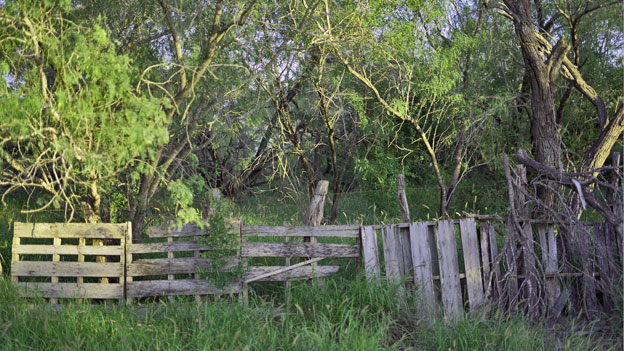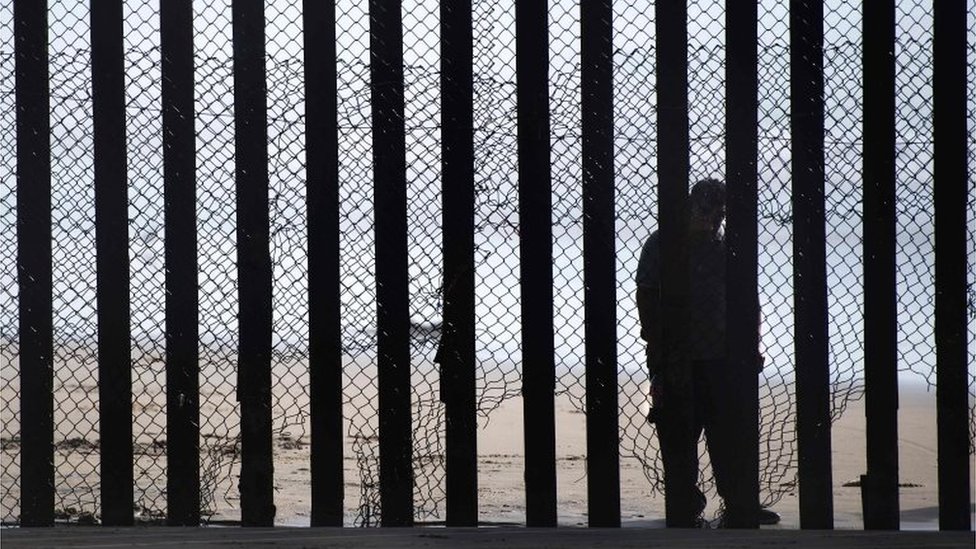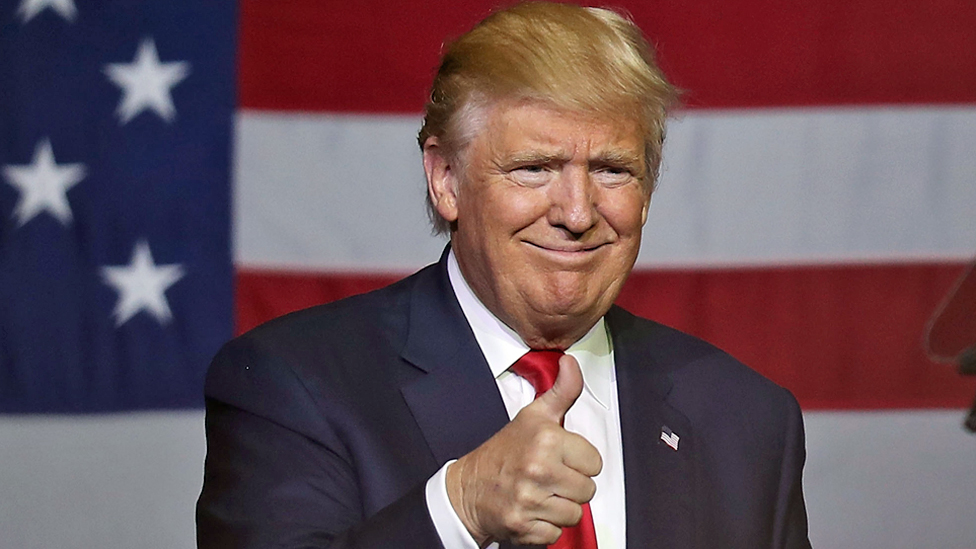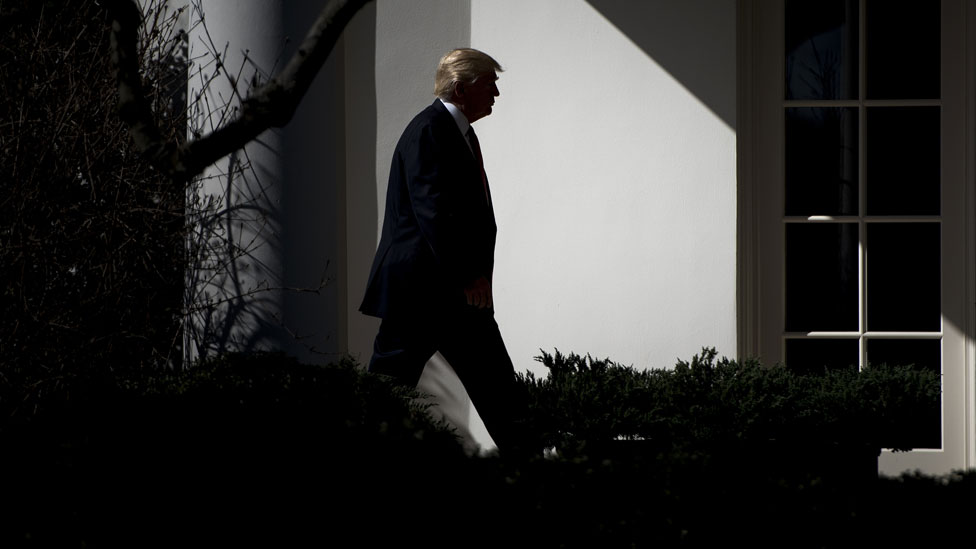6 things that could topple Donald Trump's border wall
US President Donald Trump’s promise to build a "big, beautiful wall" between the US and Mexico was a rallying cry throughout his election campaign.
As president, Mr Trump has asked for design ideas for the barrier, with a chosen few to be selected this month for a prototype showcase this summer in San Diego, California.
Mr Trump says he wants a wall along half the 2,000-mile (3,100km) border - with nature, such as mountains and rivers, helping to take care of the rest.
However, the route crosses difficult terrain, is home to a lot of wildlife and cuts across land owned by Native American tribes as well as private citizens.
So is building the wall actually possible? Here are some of the obstacles Mr Trump will have to overcome.

The border is really twisty and some of it is in a river
As it runs from San Diego, California, in the west, to Brownsville, Texas, in the east, it changes from relatively straight lines to following the windy path of the Rio Grande.


In fact, the actual border is, in many places, defined as the deepest channel of the river.
Building a wall in the middle of the Rio Grande would be challenging for obvious reasons, but there are also legal issues. A treaty signed by Mexico and the US in 1889 prevents any disruption to the flow of the river, meaning any border wall would probably have to be built on its banks. This, again, presents obvious problems.
Existing border fencing often sits far from the river, outside its floodplains, leaving a wide gap between the fence and the official border.
This means some US citizens have been forced to live on the Mexican side of the fence in a kind of limbo between the two countries.
I think if you look at this place from the air, you wouldn’t notice that a political divide went down the middle of that river, because the ecosystem is whole and protected. But it takes two nations to do so. Jennette Jurado, park ranger for Big Bend National Park
There are sand dunes and mountains
While two thirds of its length runs along rivers, the southern US border also bisects other challenging environments - desert in California and Arizona and mountains in New Mexico.
In eastern California, there are the Algodones - or Imperial Sand Dunes - the largest sand dune ecosystem in the US. There is already a section of “floating fence” here, specifically engineered to work with the shifting sands, installed by the George W Bush administration.

Meanwhile, Arizona and New Mexico are mountainous. Coronado National Forest, in southeastern Arizona and southwestern New Mexico, has several 9,000-ft peaks.
A wall appears impossible here.

There’s a lot of wildlife
The US-Mexico border has a delicate ecosystem that could be disrupted by any new barrier.
A wall would prevent animals reaching their hunting lands, water sources and migration corridors. Grey wolves and jaguars hunt on both sides of the border. Other cross-border populations of wildlife include bison, bighorn sheep, ocelots and bears.
Splitting these animals will not only decrease genetic diversity but also make species susceptible to diseases and epidemics, conservationists have warned.

Protecting the wildlife along 12% of the US-Mexico border is the task of Big Bend National Park in West Texas, home to thousands of species, including more types of birds, bats, and cacti than any other national park in the US.
Staff there are concerned that any barrier would impact greatly on their mission to protect the Chihuahuan Desert’s ecosystem for future generations and jeopardise relationships with colleagues working on the other side of the Rio Grande.
Jennette Jurado, Big Bend public information officer and ranger, says this collaboration with Mexican neighbours is crucial to her conservation work.
“I think if you look at this place from the air, you wouldn’t notice that a political divide went down the middle of that river because the ecosystem is whole and protected,” she says, “but it takes two nations to do so.”
Mike Davidson, a guide at Big Bend, agrees that cooperation has been crucial to wildlife protection and says building a wall or other structure would be “really sad”, detracting from people’s desire to come to Big Bend.
“Why come down here when there’s a big blank wall instead of these beautiful canyons?”

Mr Trump’s initial price tag of between $8bn and $12bn (£6.4bn and £9.7bn) has been widely disputed.
The 650 miles of fencing built under President George W Bush cost an estimated $7bn, and it could not be described as fulfilling Mr Trump's promises of a "tall, powerful, beautiful" barrier.
A number of very different estimates have been put forward by other official bodies.
Mitch McConnell, the Republican majority leader in the Senate, stated the cost would be between $12bn and $15bn, while a report by the US Department for Homeland Security estimated the wall would cost between $21.6bn and $25bn.
Meanwhile, a report by Senate Democrats, said the wall could cost nearly $70bn to build and $150m a year to maintain.
On day one, we will work on an impenetrable, physical, tall, powerful, beautiful southern border wall. Donald J Trump
Other, unofficial, estimates have varied.
Wall Street research and brokerage firm Bernstein Research said the price tag could be between $15bn and $25bn, while construction consultants Gleeds believe it would be in the region of $31bn.
Meanwhile, Konstantin Kakaes, an international security fellow with the New America Foundation writing in the MIT Technology Review, said the total could reach $40bn.
One thing’s for sure, it’s going to be expensive, and so far, the cash hasn’t been found.
In his proposed budget unveiled in March, Mr Trump allocated $1.4bn for wall construction in the ongoing fiscal year, with another $2.6bn for the 2018 budget year starting on 1 October.
However, Congress didn’t approve any funding for wall construction this year (only cash for repairs to 40 miles of older fencing) and Mr Trump has now reduced his request to $1.6bn - down £1bn - for 2018. An additional $1bn is allotted to border “technology and infrastructure”.
According to the Department of Homeland Security, the £1.6bn would be spent on 74 miles of barrier, mostly in the Rio Grande Valley.

While Mr Trump originally promised to build a wall along the whole 2,000-mile border, he later clarified that it would only cover 1,000 miles due to “natural barriers”. As for height, he has given estimates ranging between 30ft and 50ft.
In March, the Department of Homeland Security and Customs and Border Protection clarified the government’s requirements.
In addition to the complex structural work, there is the surveying, land acquisition and access road-building, among other things, he says.
Inviting companies to submit designs, the FedBizOpps.gov website stated the “cost-effective” structure must be made of reinforced concrete and:
- Be “physically imposing in height”, towering at least 18ft above the border
- Be impossible to breach with a ladder or grappling hooks and require at least an hour to breach with tools
- Be sunk at least 6ft into the ground to prevent tunnelling
- Blend in with the “surrounding environment” and be “aesthetically pleasing” from the north side
- Include 25ft and 50ft gates for pedestrians and vehicles
New York-based structural engineer Alex Weinberg told the BBC that a wall, “even one of this size”, was not difficult in terms of engineering because there was “nothing to engineer”. Instead, the “big task” would be the scale of the operation.
“It’s the logistics that are the real challenge here,” he said.
Land would need to be surveyed and acquired, foundations dug and construction materials made. On top of this, because of the remote location of much of the construction site, access roads would need to be built and supplies, accommodation, transport and medical care would need to be provided for the required large labour force.
“It’s going to be a slog,” Mr Weinberg said.
Fencing introduced by George W Bush

However, the government, alongside its call for concrete wall designs, has asked for submissions for a “see-through component/capability” that “facilitates situational awareness”.
This appears to suggest that the government is considering building out of materials other than concrete - something Homeland Security Secretary John F Kelly, a retired general, also told senators on the Homeland Security Committee this month.
“It is unlikely that we will build a wall from sea to shining sea,” he said.
However, he added that physical barriers would be "put in the right places" and that sensors, drones and other technology would fill in gaps where a wall would not be present.

In order to build the wall, the government needs permission to use the land it stands on.
However, about 66% of land along the US-Mexico border is either owned privately, by Native Americans or by individual states.
In these cases, the government will need to coordinate mass voluntary sales of property or negotiate a right of way for the wall along large swaths of land.
Thousands of homeowners could be affected, including ranchers in Texas - among them Donald Trump supporters - who rely on access to the Rio Grande and pastures for their livestock.
I want the wall because it's not going to be permanent. It's not going to be forever into eternity. It's just until people come to their senses. Rene Villareal, Texas landowner
Trying to purchase this land could be a major challenge and if people refuse, the government would have to forcibly get hold of it.
Welcome to the term "eminent domain".
Eminent domain is a system used to gain ownership of private property for public use, such as for highways and railroads, usually accompanied by compensation. It has been used for the construction of border fences in the past.
Gerald S Dickinson, assistant professor of law at the University of Pittsburgh Law School, has warned that such eminent domain fights could take years.

Any federal eminent domain action on such a large scale against even a few landowners could trigger “decades of court disputes before anything is built”, he told the Washington Post.
In the 2000s, the Bush administration had to negotiate land purchases with hundreds of landowners. Many citizens and local governments mounted resistance, causing major delays.
Among them was a family who lost half their farmland and their house and are now forced to live on the Mexican side of the fence, only accessing the US side via a locked gate into which they have to punch in a passcode.
Democratic Senator Claire McCaskill told the Senate Homeland Security Committee that out of 400 land acquisitions needed for the fencing that currently exists, 330 lawsuits were filed by the Department of Justice and more than 90 of those cases were still pending.
However, some landowners are receptive to the current administration’s moves.
The Villareal family, whose property lies just outside Rio Grande City, Texas, and borders the river, say they now feel better protected under President Trump because of his hardline approach to immigration.
“I do feel safer,“ says Daniel Villareal. “I mean, we've always come down here [to the river] armed, ever since we're sort of having the problem [of illegal immigrants crossing their land].
“But now that the situation's different, and there's not that many people trying to come across, maybe we can come down here, clear this area and then have our riverbank.”
The family was approached by the Bush administration when it was researching areas to build a fence, but nothing came of it. Rene Villareal, Daniel’s brother, says the family would not oppose plans for a wall across their property if it helped prevent more people crossing the border illegally in the short term.
“I want the wall because it's not going to be permanent,” says Rene. “It's not going to be forever into eternity. It's just until people come to their senses.”
But, while some private property-owners may not object, the proprietors of Tribal lands have already voiced firm opposition. The Tohono O’odham Nation owns much of such land, including a reservation that extends along 75 miles of the border in Arizona.
Tribe members still live on both sides of the border, considering the territory their ancestral lands, and have indicated they will attempt to block construction if the wall goes ahead.
Should that happen, Mr Trump would need a bill from Congress to acquire the land, which is currently protected under law.

As many have pointed out, a strip of concrete stretching across the continent would not keep people out indefinitely unless it is manned by border guards.
Homeland Security secretary, John F Kelly, has himself said that a “physical barrier will not do the job” and that you would have to back it up with patrolling human beings, sensors and observation devices.
In executive orders issued five days after his inauguration, Trump called for the recruitment of an extra 5,000 Border Patrol agents and 10,000 immigration officers, but budget requests so far would only pay for 500 border agents and 1,000 immigration officers.
Marlene Castro, supervisory border patrol agent in the Rio Grande Valley sector, believes adequate staffing is part of the package of measures needed to secure the border.
“You can have all the technology and infrastructure, but if you don’t have the personnel to respond efficiently and effectively then it becomes useless,” she says.
Ms Castro has seen the number of illegal crossings in her area go down since Donald Trump was elected, but at the same time, she and her fellow agents have experienced a rise in assaults against them. She puts this down to the frustration felt by those enabling illegal entry into the US.
“The smugglers are pretty desperate right now… of course this is just an assumption, I can’t speak for a smuggler, but I’m thinking they’re losing a lot of money because of the lack of people coming across.”
No wall, no matter how beautiful, how big or how expensive is going to stop people that are desperate, people that are needy and people that are poor. Tony Estrada, Santa Cruz County sheriff
One of those people smugglers, known locally as “The Horse”, says his business was impacted by the Bush administration’s fence and that a bigger wall would “complicate” the people-smuggling trade further. However, he warns that the Mexican mafia “will always try to find a way to cross” and that prices would simply increase.
Tony Estrada, Arizona’s Santa Cruz County sheriff, agrees that people will still find a way through.
“No wall, no matter how beautiful, how big or how expensive is going to stop people that are desperate, people that are needy and people that are poor.
“These people are coming from thousands and thousands of miles at great expense and in great danger. They have been victimised most of the way. Do you think a wall is gonna stop them? No, it’s just going to be another obstacle.”

Sealing off the border would also affect the economies of border towns and affect the wider US-Mexican economy - something many US politicians would be keen to avoid.
Communities along the US side of the border have developed close and dependant economic relationships with their sister cities in Mexico. Many Mexican towns are home to US factories employing thousands of people and Mexican shoppers spend billions of dollars in US border states every year.
The supply of cheap labour in Mexico has also fuelled the rise of manufacturing plants - known as maquiladora - along the border.
These maquiladoras - or maquilas, for short - enjoy tax breaks and produce and export goods, a legacy of the North American Free Trade Agreement which came into force in 1994, scrapping many tariffs between the US, Canada and Mexico.

The wall could also impact on the wider US-Mexico economic relationship too. Mexico is America’s second largest export market and America is Mexico’s largest.
The two countries have a “very deep” economic relationship, explains Christopher Wilson, deputy director of the Mexico Institute at the think-tank the Wilson Center, with five million US jobs depending on it. The Wilson Center’s research suggests that if trade between the US and Mexico were halted, 4.9 million Americans would be out of work.
The two economies are now so interconnected, Mr Wilson says, that they no longer just sell finished products to each other, but instead “actually build products together”.
“Parts are moved across the border, sometime multiple times in the course of production,” he says. “Both the United States and Mexico are contributing to the value of products that are ultimately sold in the region or exported to the rest of the world.”
Research by the Wilson Center suggests that half of all US-Mexico trade is made up of this movement of parts and materials.
“At the deepest level, we’re in it together,” Mr Wilson says.
It's very difficult to break the commercial links between Mexico and the US. The US saves [money] here in Mexico. That's what is at risk. Jose Antonio Garcia Fuentes, a truck driver living in Nuevo Laredo, Mexico
Truck driver Jose Antonio Garcia Fuentes, living in Nuevo Laredo, Mexico, knows very well how much the two sides of the border rely on each other.
President of a company of 50 truck drivers, Jose crosses the border every week and worries about the changes a new barrier would bring.
“Imagine if there are 14,000 trucks crossing every day here and then 4,000,” he says. “There would be truck drivers here without work.”
He also points out that moving jobs and manufacturing businesses back into the US, as President Trump has promised, could have a detrimental impact on both countries.
“The labour is more expensive [in the US]. They pay US$14 an hour to a worker. With that you can pay three Mexicans,” he says.
“That is why it's very difficult to break the commercial links between Mexico and the US, the US saves [money] here in Mexico. That's what is at risk.”
Share this story
Credits
Field reporting, video journalism and photography by Paul Harris and Kelvin Brown. Words and production by Lucy Rodgers. Data journalism and production by Nassos Stylianou. Design and illustration by Lilly Huynh. Development by Rosie Gollancz, Becky Rush and Joe Reed. Big Bend photography by Ben Greenhoe. Other imagery by Getty. Border map data source: Reveal from The Center for Investigative Reporting and OpenStreetMap contributors




